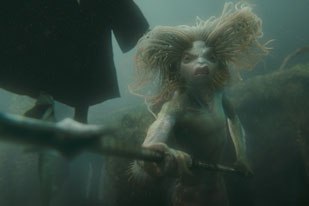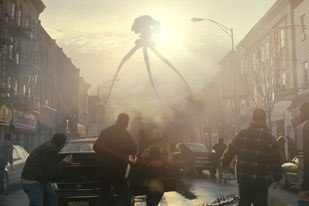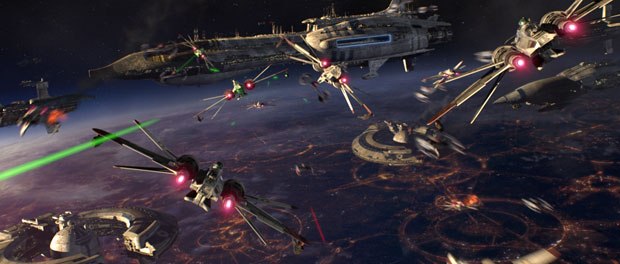Jill Smolin reports on the particularly stunning and diverse work that was on display at the Academys VFX Bakeoff.
The Visual Effects Bakeoff exploded onto the screen Wednesday night with incendiary space battles, skeletal nemeses, attacking squirrels, bats lots of bats New York as it hasnt existed for 70 years, a giant gorilla, miniature dragons, flying horses, a monumental bridge explosion, attacking tripods, a menagerie of talking animals, including centaurs, beavers, unicorns and, of course, a majestic lion.

Just another ordinary night in the fabulous world of vfx.
This annual event at the Academy of Motion Pictures Arts and Sciences was, as usual, filled to the rafters with visual effects professionals, enthusiastic students, potential nominees and members of the visual effects branch of the academy. But, unlike the rest of us, they were actually there to narrow this field from seven films to three, which would then be put to the entire academy to determine the team that will receive the coveted Oscar on March 5.
OK, back to the Bakeoff. As he has for the last decade or so, Richard Edlund, the outgoing chair of the executive committee of the vfx branch of the Academy of Motion Picture Arts and Sciences, introduced the evening, noting that by secret ballot the steering committee chose seven films from 311 eligible movies. He noted that its helpful to see these films at the Bakeoff; they were chosen by the nomination committee. Theyre the shining movies. Visual effects supervisor Jeff Okun (last years Elizabethtown) concurs, Each of the nominated films would win the award hands down if they were in separate years! That is what is so amazing about this batch of films. Each is incredible in its own right. Its comments like those that make me happy I dont have to do the choosing!

This usually festive night buzzed with an enthusiasm I love about this industry. Its an enthusiasm that seems almost contradictory to the relative solitude necessary to create all those creatures, cars, battles and the thousands upon thousands of skies, textures, paintings and composites that slip by unnoticed as we do what the director intended: sit in a darkened theater, ignore our popcorn and red vines, and get completely absorbed in the story. And thats the big carrot we as an industry seem to be munching on right now: This industry has succeeded in creating the tools, and the artists who master them, that allow directors to tell extraordinary stories. As Edlund so eloquently observed: Whether its an actor, or a lion or an ape; whether its 50 guys rowing a boat or a caped crusader saving a town, without the visual effects, the movie would be naked, so to speak. Visual effects clothe the movies and are key to the movies success. The evening would prove this point without a shadow of a doubt.
The films were presented in an order determined by lot, as Edlund says. They were pulled out of a hat (Ive always wanted to see that hat is it like the Sorting Hat in Harry Potter?), so our evening started with Star Wars: Episode III Revenge of the Sith (John Knoll, Roger Guyett, Rob Coleman and Brian Gernand). Blasting onto the screen was the space battle of the century this and any other. The work is exemplary as audience members, were so spoiled by ILMs work and I was only sorry we didnt get to see more of the 2,400 shots: but what are you going to do when your effects reel is 90 minutes long?
You know its going to be a good Bakeoff when the first question is thrown out by the always-eloquent Bill Taylor, who asked about models and miniatures. Of which there were, according to vfx supervisor Knoll, about 80,000 hours worth. In case there was any thought that our industry was done with practical effects, the evening would reveal many more films that made extensive use of them.
From the extreme reaches of space, we moved into Tim Burtons alternate psychedelic universe, Charlie and the Chocolate Factory (supervised by Nick Davis, Chas Jarrett, Jon Thum and Joss Williams). This strange and fabulous universe featured a 120 square-foot model and singing and dancing 2'4" Oompa-Lompas, performed by a single four foot-ish actor, Deep Roy, who could neither sing nor dance; and whose performance(s) could be attributed to some great motion capture, match moving, roto and animation.
King Kong came next, where we were treated to an insanely huge view of New York, circa 1933 from both street and airplane heights (supervised by Joe Letteri, Brian Vant Hul, Christian Rivers and Richard Taylor). As such, King Kong has two giants: the city and the ape. The city was created by integrating a dataset of New York and removing any buildings, post-1933. As a creature, Kong evolved out of Wetas work creating Gollum with more advanced facial capture capabilities. Andy Serkis eye movements, for instance, were tracked and motion captured (both above and below the eyelid), and the movements transferred to the digital gorilla, lending him a humanity achievable through the talents of the actor and the animators. Paraphrasing, at the end of the films presentation, Richard Taylor remarked that the audience cried at the end of this film, lifting the art of CG to the level of emotion, raising the bar for the future of what we create in this room. That comment applied again to work we were to see later in the evening.
Batman Begins was next out of the hat, with vfx supervisor Janek Sirrs explaining how director Christopher Nolan wanted to create a character-driven film featuring many, many bats, a super-talented car that could jump 65 feet in the air, a city disrupted by a careening elevated train and a succession of geysers and characters, some of whom flew, and others with ghastly metamorphosing visages. Oh, and he wanted the effects to be invisible; Im not sure I want to live in a world where these effects would be considered invisible. However, the world created by the visual effects and special effects teams (also including Dan Glass, Chris Corbould and Paul Franklin) was remarkable, indeed. Beautiful all-digital panoramic cityscapes, a bevy of practical effects that ranged from a 150-foot high large-scale miniature dubbed a bigature, a million still pictures, a radio-controlled Batmobile and thousands of digital bats provided a persuasive universe for this compelling prequel.

Harry Potter and the Goblet of Fire, which, like Star Wars, has been a staple at the Bakeoff for the last several years, used 60,000 digital doubles in a massive (geekpun intended) stadium whose upper tiers were built close to the ground to ensure the safety of the actors. This beautiful film again reinforces that technology placed in the hands of talented artists can take us outside of ourselves, and transport us to an alternate world where imagination is everything. The 15-minute clip treated us to flying horses, miniature dragons and their full-size counterparts. In addition, there were flying books, nose replacements, forced perspective and some really convincing underwater shots that, well, were actually shot under water.
War of the Worlds provided an entirely different view of the universe; one where evil lurks below until it forces its way above. Because of its crazy short schedule, this film was co-supervised by Pablo Helman and Dennis Muren (Randy Dutra and Daniel Sudick rounded out the slate). This production sounded as close to an improvised documentary as you can get with a visual effects film. Helman commented that what started as a gas station blowing up as seen through a side mirror evolved (quickly) to the extraordinary bridge explosion shot, which featured cars, an 18-wheeler and huge explosions. Oh, and they had but four weeks to complete the exploding bridge, which led Helman to note that theyd lost complete control of the visual effects process. Hmmm. Doesnt sound like ILM at all.

Wrapping up the evening was The Chronicles of Narnia: The Lion, the Witch and the Wardrobe, whose effects reel was introduced by vfx supervisor Dean Wright (joining him on the slate were Bill Westenhofer, Jim Berney and Scott Farrar). Presenting a veritable menagerie of animals, Dean noted that director Andrew Adamson had three directives, to make it look real, make it feel real and get it done. No problem. This production is remarkable for numerous reasons: aside from accomplishing those goals, in addition to some really cool interaction between CG characters and their human counterparts, it involved participation from visual effects companies from just about every continent. Files were shared and, in some cases, the three main effects houses Rhythm & Hues, Sony Pictures Imageworks and ILM contributed elements to the same shot, which meant they had to share digital files among three completely different pipelines. Thats as remarkable, I think, as the fact that Aslan the lion was created out of mere pixels. And thats due to a combination of Adamsons direction, Liam Neesons acting and the teams of animators that brought him (and his digital costars) to life. They allowed me to get lost in the story, which is what its ultimately all about.

The evening ended with the genial Edlund noting that his term was complete and he was stepping down for at least a year, as the academy requires. The room rose to its feet to applaud the man who was ending the 11th year of his nine-year term.
Now we all get to wait until early Tuesday morning, when the three nominees are announced; three nominees chosen by peers who understand all too well how the models are built, the characters rigged, the mattes are pulled and the pixels are pushed. As Edlund observed, The technology people have built us a Stradivarius, and the more we play it, the better we get. As this impressive lineup of films revealed, its difficult to imagine artists playing their instruments any better!
Jill Smolin has been a grateful member of the visual effects industry for about a decade, and has documented the industry (before it was one) for about twice that long.










